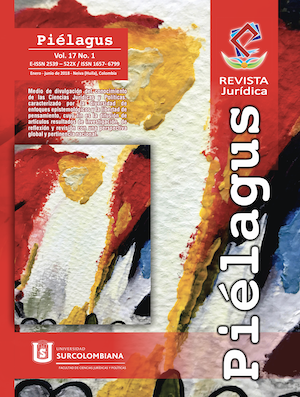Public transportation through cables within environmental, social and economic aspects: analysis of legislation and regulation in Colombia (1989-2015)
Análisis de la legislación y normativa en Colombia (1989-2015)
##plugins.themes.bootstrap3.article.main##
Around the world, cable transport systems have shown benefits from environmental protection, social equity, and economic value; at the same time, they have resulted as initiatives in Latin American countries through their implementation as a collective urban public transport system.
It is observed the incursion of this type of systems in Colombia, at the same time that there are concerns about its benefits and the sufficiency of the public policies that support its implementation.
The present work aims to detail the benefits of the implementation of integrated cables to public transport systems in cities; also, assess public policies around those. The methodology is oriented to establish, on the review of the available literature, the environmental, social and economic benefits of cable transport. Consecutively, through the use of a contrast matrix for the qualitative analysis of policies, make the assessment of legislation and normative for regulation, promotion and development related to urban public transport through cables in the Colombian context as well as plans, programs and projects.
The results show gaps in legislation and regulations, as well as in national plans. It is concluded that public policy is not enough and requires the intervention of the State in the matter, with a view to the implementation and exploitation of transport systems using cables in the cities of Colombia.
Downloads
##plugins.themes.bootstrap3.article.details##
II. Blanco, H. (2011). Metodología de evaluación de políticas públicas de vivienda y transporte urbano bajos en carbono. Santiago de Chile: Comisión Económica para América Latina y el Caribe CEPAL, Naciones Unidas.
III. Brand, P. y Dávila, J. (2011). Aerial cable-car systems for public transport in low-income urban areas: lessons from Medellin, Colombia. Track 11 (Transportation, Infrastructure and Planning) at the 3rd World Planning Schools Congress (4 a 8 de Julio de 2011), Perth, Australia.
IV. CERTU (2011). Aerial cableways as urban transport systems. Centre d’études sur les Réseaux, les Transports, l’urbanisme et les Constructions Publiques CERTU, Service Technique des Remontées Mécaniques et des Transports Guidés STRMTG, Ministère de l’Ecologie, du Développement durable, des Transports et du Logement. Lyon: CERTU.
V. European Commission (2009). Evaluation of the Common Transport Policy (CTP) of the EU from 2000 to 2008 and analysis of the evolution and structure of the European transport sector in the context of the long-term development of the CTP. London: Directorate-General Energy and Transport, European Commission.
VI. Heinrichs, D. y Bernet, J., S. (2014) Public transport and accessibility in informal settlements: aerial cable cars in Medellín, Colombia. Transportation Research Procedia, Volumen 4, pp. 55-67. DOI: 10.1016/j.trpro.2014.11.005
VII. Leibler, L. y Brand, P. (2012). Movilidad e inclusión social: la experiencia desde la periferia de Medellín y el primer Metrocable. Bulletin de l’Institut Français d’Études Andines, Volumen 41 (Número 3), pp. 364-387. DOI: 10.4000/bifea.147
VIII. Mwarania, E. (2016). Ropeways in the urban environment. En International Conference on Transport and Road Research (16 a 18 de Marzo de 2016), Whitesands Hotel, Mombasa, Kenya.
IX. Nikšić, M. y Gašparović, S. (2010). Geographic and traffic aspects of possibilities for implementing ropeway systems in passenger transport. Promet - Traffic & Transportation, Volumen 22 (Número 5), pp. 389-398. DOI: 10.7307/ptt.v22i5.204
X. Orro, A.; Novales, M. y Rodríguez, M. (2003). Transporte por cable. Cuadernos del Grupo de Ferrocarriles y Transportes. Escuela Superior de Ingenieros de Caminos, Canales y Puertos, Universidad de la Coruña. A Coruña: Editorial Tórculo Artes Gráficas.
XI. Quintero, J. (2017). Valoración de las políticas públicas para la promoción y desarrollo de sistemas de transporte alternativo urbano en Colombia. Trabajo de Grado de Maestría, Maestría en Derecho Privado, Persona y Sociedad con Énfasis en Transporte, Logística e Infraestructura, Departamento de Derecho del Transporte, Facultad de Derecho, Universidad Externado de Colombia, Bogotá D.C.
XII. Quintero, J. y Quintero, L. (2015). El transporte sostenible y su papel en el desarrollo del medio ambiente urbano. Revista Ingeniería y Región, Volumen 14 (2), pp. 87-97.
XIII. Quintero, J.; Ramírez, Y. y Cortázar, A. (2015). El transporte por cables y su papel en la movilidad urbana sostenible. Manuscrito no publicado.
XIV. República de Colombia. Alcaldía de Medellín (2014). Plan de movilidad segura de Medellín 2014-2020: movilidad para la vida. Primera Edición. Medellín: Editorial Dinámica.
XV. República de Colombia. Consejo Nacional de Política Económica y Social (2003). Documento Conpes 3242: estrategia institucional para la venta de servicios ambientales de mitigación del cambio climático. Bogotá D.C.: CONPES.
XVI. República de Colombia. Consejo Nacional de Política Económica y Social (2003). Documento Conpes 3260: política nacional de transporte urbano y masivo. Bogotá D.C.: CONPES.
XVII. República de Colombia, Contraloría de Bogotá D.C. (2014). Evaluación de la política pública de movilidad. Bogotá D.C.: Dirección de Estudios de Economía y Política Pública, Contraloría de Bogotá D.C.
XVIII. República de Colombia. Departamento Nacional de Planeación (2015). Plan nacional de desarrollo 2014-2018: todos por un nuevo país. Bogotá D.C.: DNP.
XIX. República de Colombia. Ministerio de Transporte (2015). Plan Nacional de Seguridad Vial Colombia 2011-2021. Segunda Edición. Bogotá D.C.: Mintransporte.
XX. Zapata, D.; Stanley, J. y Stanley, J. (2014) Reducing social exclusion in highly disadvantaged districts in Medellín, Colombia, through the provision of a cable-car. Social Inclusion, Volumen 2 (Número 4), pp. 1-13. DOI: 10.17645/si.v2i4.127
REFERENCIAS NORMATIVAS
XXI. D. 2263/1995
XXII. D. 3109/1997
XXIII. D. 1072/2004
XXIV. D. 364/2013
XXV. D. 736/2014
XXVI. D. 2060/2015
XXVII. L. 86/1989
XXVIII. L. 105/1993
XXIX. L. 310/1996
XXX. L. 336/1996
XXXI. L. 1083/2006
XXXII. L. 1682/2013
XXXIII. L. 1753/2015
XXXIV. R. 0627/2006

















